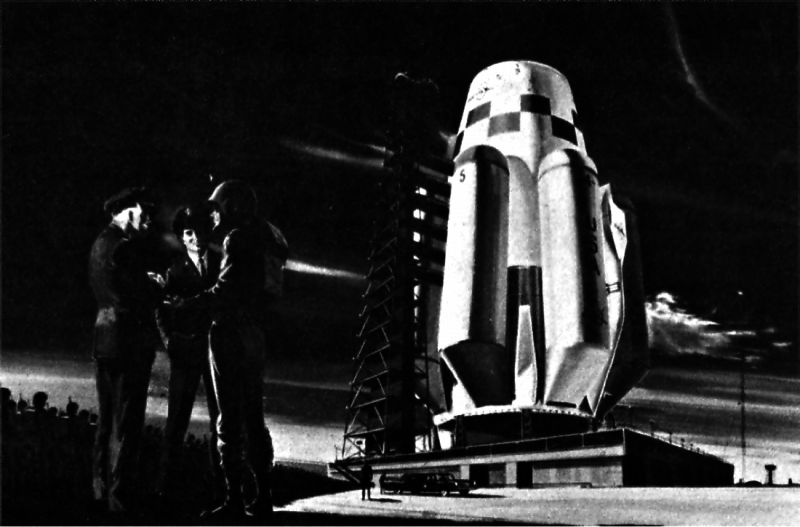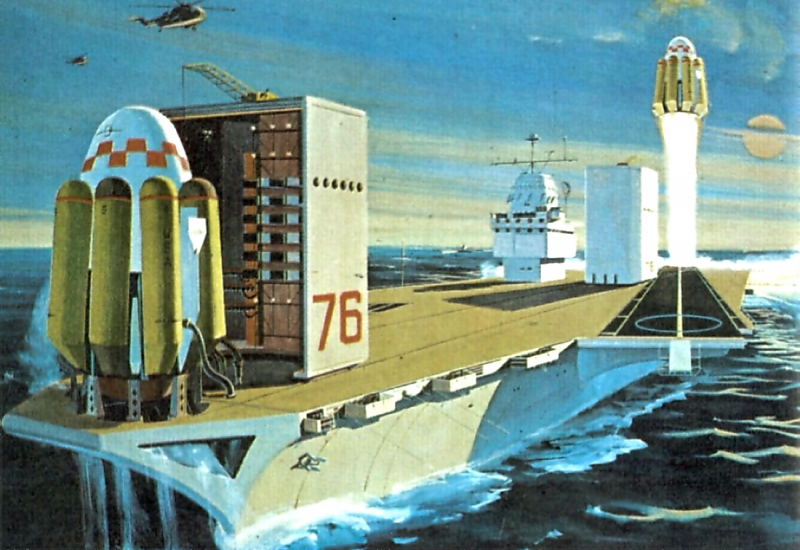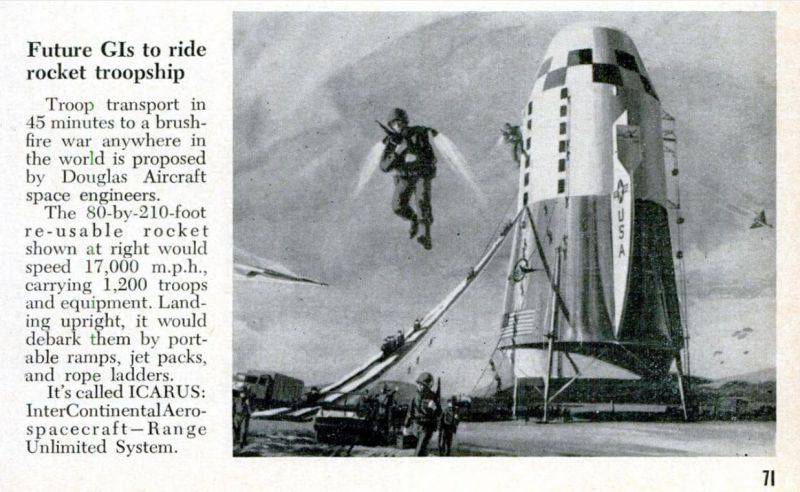Douglas ICARUS / Ithacus Amphibious Missile System Project
The most important element of the US armed forces is the Marine Corps. In the event of an armed conflict, the marines should be the first to go to the combat area and hold a bridgehead until the main forces arrive. Such a strategy places special demands on the means of transporting troops. Creating a full-fledged combat-ready grouping should be carried out as soon as possible, for which a developed fleet of vehicles is needed. Over the past decades, various projects of such systems have regularly appeared, which should have ensured the speedy transfer of troops over long distances.
In the fall of 1963, General Wallace Green Jr. was appointed Commandant of the Marine Corps. Soon, the new commander, planning to increase the mobility of the formations, proposed to consider several original ways of transporting troops, including using promising missile systems. The general believed that rocket technology could be of great interest for the ILC and in the long term would make it easier to transport troops over long distances.

The landing of an ICARUS / Ithacus rocket as presented by the artist. Picture by Scott Lawther, Douglas Aircraft / Medium.com
It should be noted that the first such proposals appeared in the mid-fifties. Under the leadership of Werner von Braun, a conceptual design of the landing craft based on the Jupiter ballistic missile was developed. It was proposed to equip the rocket with a special “passenger” capsule with seats for several dozen people. A bit later, a similar system based on the Redstone rocket was proposed. Both of these projects offered to deliver a landing party to the landing site. For a soft landing, the capsules had to be equipped with parachutes and braking rockets. Both proposals did not interest the military, since they did not have any noticeable advantages over the existing equipment, and they were also inferior to it in some parameters. For example, the range of both missiles was at the level of the range of helicopters of that time.
At the initiative of General Green in 1963, a new project of a similar purpose was launched. Soon the defense ministry collected the projects of several private companies and decided to order the development of the promising landing rocket system to the firm Douglas Aircraft. Its employee, Philip Bono, proposed a variant of such a complex, partly resembling the designs of von Braun, but having a lot of serious differences.
According to F. Bono, the use of existing launch vehicles or ballistic missiles as a base for the promising CMP technology did not make sense. It was necessary to create some kind of new rocket with acceptable characteristics. In particular, it was necessary to use rocket engines of a new type, as well as a number of other original ideas. All this made it possible to solve the main problems associated with the range and payload size. In addition, it was possible to immediately make the system under the requirements of the Marine Corps.
Shortly before the start of work on the landing system F. Bono and his colleagues were engaged in the Rombus project. It was a new booster that could be used to put various loads into orbit. Among other things, the possibility of carrying a reusable manned vehicle was considered. Rombus rocket was equipped with a large central tank for an oxidizer and several tanks for hydrogen on the outer surface. In addition, the project proposed to use the aerispike power unit. Its main feature was the use of a large number of engines or individual combustion chambers located around the circumference. Due to the addition of the thrust of many engines, it was possible to ensure the highest total thrust.
In the near future, the Rombus system could become a new launch vehicle for the space program and put various loads into orbit. However, at the end of 1963, the authors of the project decided to abandon this use of the advanced system and offer it to the command of the Marine Corps. The calculated characteristics made it possible to equip the rocket with an original module for the transport of personnel and, possibly, of some equipment and weapons. Having changed its purpose, the Rombus project received a new name: ICARUS (InterContinental Aerospacecraft Range-Unlimited System - “Intercontinental Aerospace System of Unlimited Radius of Action”). Later the project changed its name again. The third name was Ithacus.
The ICARUS project was a modified version of the base Rombus with a number of innovations directly related to the original payload in the form of personnel and equipment of the Marine Corps. At the same time, the main features of the project remained unchanged. It was proposed to build a relatively large reusable rocket with places to accommodate soldiers and a separate cargo compartment for equipment or other goods.
The main element of the rocket was supposed to be a body with a diameter of about 80 feet (a little less than 25 m) and a height of 210 feet (64 m). In the lower part of the body it was proposed to place a set of a new type of liquid rocket engines. It was planned to use liquefied hydrogen and oxygen as fuel. Part of the fuel and oxidizer tanks could be placed in the case, the rest was planned to be mounted on the outer surface of the case. In the lower part of the hull should have been support for takeoff and landing.

The loading of troops on the rocket in the artist's view. Picture by Scott Lawther, Douglas Aircraft / Medium.com
The head of the hull of the ICARUS / Ithacus rocket was given for placing the payload. Approximately half the height of the hull should have occupied six decks, floors with seats for the landing. On each of the decks it was possible to place 200 anti-grip seats for the fighters, which made it possible to transport up to 1200 soldiers with weapons. There was also the possibility of constructing cargo rockets with an appropriate arrangement of compartments for payload.
At the suggestion of the engineers of Douglas Aircraft, the missile with the landing force was supposed to take off from a special launch pad at one of the American military bases and be sent to the landing zone. It was proposed to fly along a ballistic trajectory: after lifting and accelerating, the ICARUS system had to cover part of the distance, going beyond the limits of the earth's atmosphere. In the area of the target, a braking maneuver should be carried out and landed in a given territory. After that, it was possible to land the marines, which could immediately go on the attack and occupy a springboard for landing new forces.
The project implied that the rocket would sit on the tail pillars, being in an upright position. This feature of landing made F. Bono and his colleagues decide the issue of landing troops and unloading equipment. According to reports, in the rocket body it was proposed to install a large number of doors and gates equipped with various equipment. It was assumed that the soldiers would descend to the ground with the help of special telescopic ramps-ramps, rope ladders, etc. Among other things, the possibility of using jetpacks was considered. With their help, the soldiers could not only sink to the ground, but also approach the enemy.
The cargo version of the ICARUS / Ithacus system was to have a gate of the appropriate size and a set of cranes for unloading weapons and equipment. In addition, the construction of combined cargo-and-missile missiles with compartments for personnel and materiel, as well as a set of appropriate landing equipment, was not ruled out. Probably the specific layout of the compartments for the payload should have been determined by the customer.
According to the calculations of the authors of the project, the proposed architecture of the landing system made it possible to land troops in almost any part of the globe and deliver the troops as soon as possible. The estimated speed of the rocket reached 17 thousand miles per hour. Thus, the soldiers could begin to perform assigned combat missions anywhere in the world during 45-50 minutes after launch from their base. This transfer speed had a lot of advantages. First of all, it did not allow the enemy to prepare for the attack and take the necessary measures to organize the defense.
It was assumed that after the landing, the ICARUS rocket would save a small part of the fuel, which would allow it to reach the nearest sea, where it should have been taken by a special transport vessel. Independent flight to the launch pad was not provided.

Amphibious missiles Ithacus 100-T on the carrier ship. Picture by Scott Lawther, Douglas Aircraft / Medium.com
As part of the ICARUS program, drafts of two missile landing systems were developed. The second option was a complex called Ithacus 100-T. The main difference of this system from the base was the size and, as a consequence, the lower load-carrying capacity, as well as other requirements for the launch pad. The 100-T missile was supposed to be half the size of a full-fledged Ithacus and had a reduced payload. In a smaller body, only 170 paratroopers or 60 tons of cargo could be placed. The rest of the 100-T was a reduced version of the original ICARUS.
The Ithacus 100-T project had a curious feature: this version of the airborne missile could be launched from the carrier ship. As a carrier, a modified Enterprise atomic aircraft carrier or another ship with suitable characteristics was proposed. On the deck it was proposed to install a set of various equipment, in particular mobile structures with maintenance systems and other devices designed to prepare for departure.
It was assumed that the nuclear aircraft carrier would be able to provide the required power supply to all systems, including electrolysis facilities. The fuel and oxidizer in the form of liquefied hydrogen and oxygen was proposed to be extracted directly from the ocean water during the voyage. This made it possible to launch a landing rocket from anywhere in the world’s ocean and at almost any moment (depending on the amount of fuel available and other factors), as well as to solve some other tasks.
Despite the smaller capacity and carrying capacity, the “maritime” version of the ICASRUS system had some advantages over the “land” one. In particular, proper planning of the operation and the correct choice of the launch point made it possible to significantly increase the carrying capacity due to the additional acceleration of the rocket using the rotation of the Earth. In addition, such a complex did not need fuel supply and could be on duty for a long time.
The general public first learned of the new Douglas Aircraft project in February 1964, thanks to Missiles and Rockets magazine. This edition has published an article about the ICARUS project, in which the main proposals of the engineers were mentioned, and also some of the design characteristics of the complex were disclosed. Already, by this time, the team of F. Bono had planned to deliver 1200 soldiers or 130 tons of cargo to anywhere in the world. According to calculations, such a flight should take about 45 minutes.
In the same publication in the magazine Missiles and Rockets, a smaller version of the airborne missile system was also mentioned, designed to carry 170 people or 60 tons of cargo. At the same time, information on the possible use of converted aircraft carriers as a starting complex was not published. Probably, in the winter of 64, the authors of the project have not yet considered such a variant of operating their new missiles.
The ICARUS / Ithacus airborne missile system was of great interest to the military, since, in theory, it allowed the transfer of troops over considerable distances within an hour. Such a complex was able to dramatically improve the amphibious capabilities of the Marine Corps, to increase its strategic mobility and, as a result, its combat effectiveness.
However, the project did not reach implementation in practice. Despite all the apparent advantages, he had a lot of serious flaws. Chief - the complexity of the design, which did not allow to build even a workable prototype. The level of technology of the early sixties could not ensure the implementation of such complex plans. There were no necessary engines, and there could be problems with some materials needed for construction.
The proposed way of performing the flight looks too bold. The rocket was supposed to fly along a ballistic trajectory, as well as slow down in the vicinity of the target and make a soft landing. It is difficult to imagine exactly how the authors of the project planned to carry out such brake maneuvers and make a careful landing, which does not adversely affect the design of the rocket and the landing forces.
Separately, we should consider the proposed methods of transportation and landing personnel. Inside the hull of a rocket with a diameter of less than 25, it was proposed to place six decks with 200 seats for paratroopers on each. It is easy to calculate that each place for a fighter accounted for about 2,4 square. m sectional area of the hull. In this case, amendments should be made to the design features of the anti-overload seats. As a result, there is reason for doubts about the possibility of placing 1200 soldiers in the available volume while maintaining acceptable flight convenience and disembarkation.
The paratroopers had to leave a relatively high rocket through several doors in the hull, using telescopic ramps, rope ladders, or even jet packs. It can be assumed that the first two means of landing did not provide acceptable convenience, and the third required separate development work, the successful completion of which was in question.
Finally, the fate of the proposed technology could have affected the fate of the ICARUS project. Moving along a ballistic trajectory, the missile was too difficult a target for the enemy’s anti-aircraft or missile defense, but after braking, landing and during the landing, it could become an easy target for enemy aircraft and artillery. In this case, the question of the fastest landing of troops in order to reduce risks became topical.
An analysis of the project by Douglas Aircraft, conducted by experts from the Marine Corps and the US military, showed that it has no practical prospects. The only advantage of the ICARUS / Ithacus complex was the ability to quickly transfer a large number of soldiers and equipment, but that’s where the benefits ended. The prospective rocket turned out to be too complicated, expensive and inconvenient to operate, and also did not have a high chance of fulfilling the task.
The military, having familiarized themselves with the proposed project, refused to accept it and finance further work. The company Douglas Aircraft, in turn, was not able to continue development without the help of the military. As a result, the project was closed as unnecessary and sent to the archive. Perhaps, in the future, such equipment could be used in various areas, but the ICARUS project was completely closed, and the command of the Marine Corps no longer showed interest in the landing rocket systems.
Based on:
https://medium.com/
http://collectspace.com/
http://blog.modernmechanix.com/
Future GIs to ride rocket troopship. Popular Science. 1964, No.7
Douglas Proposes an Intercontinental Ballistic Transport for 1200 Troops. Missiles and Rockets. 1964, Feb 17

Information